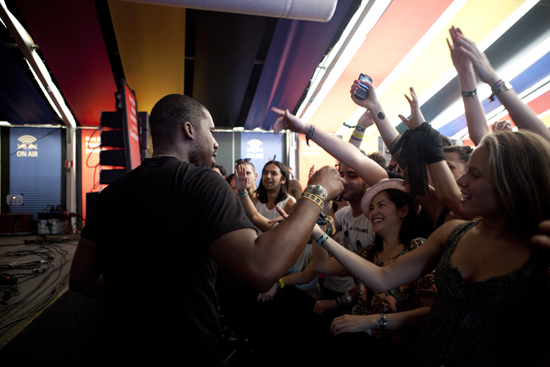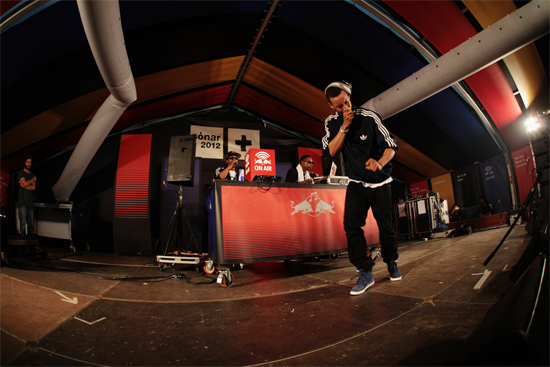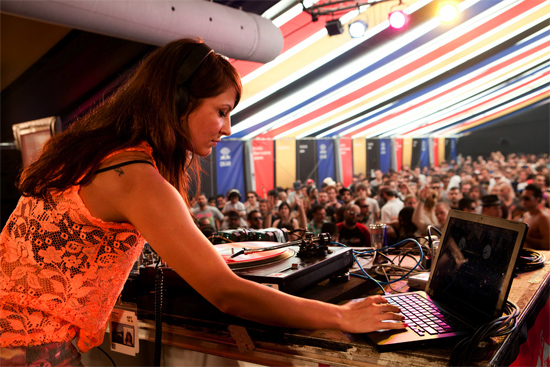Is it weird to go out raving on your own? I do it all the time – largely because my friends either lead busy lives or simply have different taste. It would be tempting to rhapsodise about ‘the music being enough’, but in reality there’s a fine art to balancing your lone ranger status with the need to be part of some wider sociality. Get it wrong and you feel awkward, observed, put-upon, a hyper-aware individual in a room full of friends getting pissed together and repeatedly barging into you on their way to the bar. Get it right, though – and not all of the factors are in your control – and you can just about merge with the broader collectivity, embody the shared energies animating the room: in other words, get it right and you’re no more unaccompanied than anybody else – or rather, you’re all accompanying each other.
Still, it’s never the most entertaining or relaxing of pastimes, so you can imagine the trepidation around heading to Barcelona, sans company, for four nights and five days of music. As soon became evident, though, I wasn’t quite alone – myself and a handful of other journalists would be under the aegis of the Red Bull Music Academy, based out of a postmodern-kitsch hotel in the Gothic Quarter, cocktailed, wined, and dined, and fed Spanish sausage on the waterfront (quiet at the back there) while Jackmaster played us some records on a small sound system. Nevertheless – and maybe it’s my asocial streak coming through – I still found myself embarking on solo missions more often than not, burning euros on one-man taxis across the city, checking and re-checking meticulously (anally) planned itineraries, carefully pacing branded energy drinks to stave off the inevitable slump.
Sonar means many things to many people: a relaxing foreign holiday with a bit of music thrown in; a comparatively civilised daytime event; the biggest rave you’ve ever been to. Taken as a whole, though, it’s nothing less than intense – we’re talking about a festival that played host to 98,000 this year at the official events alone. This review tries its best to cover all these bases. Speaking in broad terms, the festival experience can be split up into three distinct units. First up, there’s the numerous Off-Sonar events that take over the city’s clubs for several days either side of the festival. Given its scale, Sonar itself plays host to a surprisingly small number of artists – but you can be certain that virtually anyone of note who didn’t make it onto the official bill will be playing somewhere else in the city.
And so it is that, riding high on four hours’ sleep and a bellyful of cocktails, Wednesday evening sees a short ride out of the Gothic Quarter to BeCool: a slick 300-ish capacity club with a dancefloor that allegedly revolves (though I saw no evidence of it) and an Irish bar next door (Irish bars are ubiquitous in Spanish cities) where, it seems, everybody is taking the opportunity to get pissed beforehand. I arrive in time for Move D’s warm-up set; he’s predictably brilliant, but struggles with ropey sound and a crowd who seem far too pleased to be in Spain and still awake to worry much about the music.
The following night, with a nagging sense of unfinished business, I head back to BeCool for the Hessle Audio showcase. The system is sounding much better tonight – one wonders whether stern words were had with the sound engineer – and Elgato and Ben UFO turn in a characteristically pristine set of subtly leftfield house and techno to get things going. It’s funny how experiencing familiar music in a foreign setting can make you hear it with outsiders’ ears – a thought that crops up repeatedly over the weekend – and here Peverelist and Pangaea’s respective sets are both revealed in their full dystopic weirdness. While Pev’s current record bag – drawing heavily on Livity Sound and its similarly skeletal Bristol cohorts – feels streamlined and precision-tooled, it’s Pangaea’s selection that wins the prize for the most gloriously uncompromising of the festival. I’d struggle to name most of the tunes he played; many people struggled to dance to them. Their loss.
Just as Pearson Sound looks like he’s about to step up, it’s time for another midnight ride across the city, making stilted cross-lingual conversation with the cabbie regarding the origins of the eurotrance blasting out of his radio while he gleefully runs a red light or three. I get to Nitsa – what looks like a converted theatre, its huge, square dancefloor presided over by a DJ booth elevated way above head height – for the Numbers night at around 3am. It’s an odd quirk of Spanish clubbing custom that the punters, no matter how obliterated, are trusted with glass tumblers. Maybe Spanish crowds are capable of behaving responsibly, but the tourists prove they’re emphatically not, as they chuck their finished drinks on the floor as if they’re plastic. As a result the dancefloor by this point is a strange mix of aimlessness and genuine peril, its nervous energy not quite being converted into dynamism by the brooding thump of Levon Vincent’s productions. Jackmaster and Joy Orbison go for bigger gestures, perhaps in the hopes that extended filter drops and all-embracing basslines will help bridge that alienating gap between the booth and the crowd – and the strategy works to an extent. Still, though, the ‘floor feels like something to be survived rather than enjoyed, and a brief anthropo-social survey suggests you’re more likely to exchange a terse word with your neighbour than you are a smile or a pat on the back.

Flying Lotus
Really, though, Off-Sonar is only one part of the story – and a comparatively small one at that. After all, festivals are about scale, character, uniqueness – going to clubs is something you can do at home (at least it is for us spoiled London types). Sonar By Day is where the festival proper starts, nestled in amongst winding Mediterranean streets near the centre of the city. The four stages are tucked neatly around a central building and served by plenty of bars – a far cry from the endless wasteland vibe characteristic of many festival sites – and the programmers seem to have eschewed capacity-straining headliners in favour of lesser-knowns, curveballs and oddities, meaning that the venues are rarely the wrong side of hectic. In short, it’s a largely blissful experience – a place to gently lose your shit under cloudless azure skies.
Flying Lotus’ Brainfeeder label takes over the outdoor main stage for much of the Thursday afternoon, to mixed results. Thundercat’s soulful dreamscapes are transformed into hard, balls-out fusion in the hands of his three-piece band, revealing just how odd it is that this stuff is mentioned in the same breath as the woozy post-Dilla stylings of his labelmates; either way, seriously dodgy sound renders these songs largely incomprehensible.
Things are more exciting over at the Red Bull Music Academy Sonar Dome tent, where Om Unit draws a line between lean, militaristic dubstep and the frenzied footwork/jungle hybrids of his Philip D Kick alias – which leaves the door wide open for Chi-town figureheads Spinn and Rashad to absolutely blow the balls off proceedings. Starting at full intensity and working upwards, it’s gratifying to see how far the duo have come in terms of tailoring their sets to European audiences. More digestible 4×4 juke is alternated with the disorientating syncopations of footwork at its most envelope-pushing, and some knowing nods to the UK – Julio Bashmore’s ‘Battle For Middle You’ sounds better at 160bpm than it ever did at 130 – render the cultural exchange complete.
Most of Friday’s offerings don’t quite grab the attention (although the glorious sunshine proves entertainment enough). Raisa K’s acerbic gawkiness calls to mind Teenage Jesus and the Jerks, only updated for the social networking generation (sample lyric: ‘The catch of my life/ How could you propose to him via Skype?’), though her set feels like it’s missing a vital ingredient: no doubt down to her laptop having been stolen just hours before. Later, Nightwave’s [pictured at top] nervousness is betrayed in some hashed mixing, but her selection – an unlikely blend of glossy RnB instrumentals and chest-rattling ghetto house – is enough to keep things interesting. As evening approaches we end up killing time at the underground stage waiting for John Talabot to appear – and what a wise decision that turns out to be. Talabot is what 21st century disco should sound like – no knowing retro gestures, just pop opulence on top of dancefloor heft, tantric plateaus of libidinal energy washing steadily over the crowd. With the room crammed to capacity, we find what feels like a rare moment of unity as everybody lights up (the Spanish take great pleasure in flouting their recently introduced anti-smoking laws) and gets down.
Come Saturday, convalescence takes priority over seeing music, and I don’t make it onto the site until early evening. Diamond Version’s debut performance in the underground stage proves an unlikely panacea, leaving me fully prepared to catch DJ Harvey playing it unexpectedly safe (and unexpectedly techno) to a packed out RBMA tent. Harvey is an example of a dying breed: a DJ who’s brave enough – and trusts in the quality of his records enough – to let them run and run, allowing their contours to unwind slowly over ten minutes or more. When one record starts skipping sporadically, a look of faint amusement registers from behind those trademark sunglasses – but he still keeps it going to the bitter end before throwing something else on. The crowd, fortunately enough, seem more than happy to take the scenic route with him.

Spinn & Rashad, plus footwork dancer
The daytime event typically wraps up before ten, leaving us with a clear run at the third and final part of the Sonar triune: Sonar By Night. Taking place in the wee small hours of Friday and Saturday in an aircraft hangar a fair way out of town, the night-time part of the festival is typically referred to in hushed tones. By all accounts it’s not something you look forward to, so much as steel yourself for – an experience valued more for its extraordinariness than for any potential enjoyment to be found there. When we arrive on Friday night, passing the endless snaking lines of hoardings on our way to the entrance, it becomes immediately apparent why: the place is vast – almost incomprehensibly so. Spread over three stages, the total capacity must be approaching 40,000. One of the stages, hilariously titled ‘SonarPub’, could comfortably house 10,000. This is live music on a scale that you’d expect of Glastonbury, sure – but of dance music? The disjunct between initial expectations and the reality of the event is dizzying.
As such much of this first night is spent stumbling around in wide-eyed incomprehension, catching surreal fragments of music. Here a bit of Friendly Fires’ disco-pop echoing out over thousands of heads into the night sky; there Squarepusher, retina-scorching LED visuals in effect, airing the horrifically plastic stadium grotesquerie of his new album – a sound which is (perhaps unsurprisingly) fitting for the context, though no less awful for it. One focal point is Richie Hawtin in the main room, his emaciated figure a miniscule, side-lit dot against the colossal background of the hangar wall. In spite of a couple of enormous screens showing feeds from the stage, this room (more so than the others) feels less like a stadium, more like the biggest warehouse rave you’ve ever been to: just endless dark floor, dotted with occasional ceiling-hung speakers and bookended with bars, reverberating to the cavernous thud of a mnml kickdrum. Hawtin’s bordering-on-featureless aesthetic gains a new appropriateness here: music as tool and nothing else, imbuing the space with the barest functionality, if not any real vitality.
If you’re not careful, you can spend most of your time here just walking – adventuring, exploring, desperately trying not to lose your companions in the crush of a concrete jungle that could easily turn sinister. At this scale, all the lights and noise serve not to outline some collective purpose so much as to remind you of your own utter insignificance – or rather the insanely disproportionate significance of every tiny movement made by whoever’s on stage – each track selected, each note played, each miniscule nudge of a fader exploded a thousand times until it teeters on the brink of meaning nothing at all. Wherever you find yourself in the crowd, little islands of sociality are staked out, private parties are had – but they’re just that: private, anonymised through the sheer volume of bodies surrounding you, wandering past you, sharing other jokes, building other meanings from it all.
Returning the following night for the festival’s conclusion, things feel a little more comfortable – partly because we discover SonarLab, the smallest stage (capacity 6,000, maybe) and the one with the most bass. Making a beeline for the Hyperdub showcase, we settle down for the tail-end of Cooly G’s set, in which she crafts intricate latticeworks of beats on the fly – a bewitching performance, but I can’t quite shake an awareness of how comparatively miniscule the crowd is; perhaps a few hundred clustered up against the stage, whilst those further back mill around disinterestedly or are simply passing by on the way to catch Deadmau5 or Modeselektor. Kode9 fares better, ramping up from uncompromisingly futurist UK funky through to even more futurist footwork, with brief forays into anthemic trap earning the biggest response. The combination of some chuck-it-on-and-pray mixing and Scratcha’s raucous MCing (“Hyperdub shit… FUCK, OOOOFFF!!”) makes for a pretty good translation of the rude energy of London’s dancefloors at their best, but in the context it seems to be echoing out into an indifferent void – an aberration in amongst the Lucianos and Laurent Garniers of the night that’s largely misunderstood and easy to ignore. Scratcha rounds things off by proving that funky still has plenty of modernist fervour to go around, turning in one of the most arresting sets of the weekend. Again, though, Zaki Ibrahim and Cooly can’t quite seem to muster any conviction as they share mic duties, their occasional crowd-hyping sounding lacklustre, uncertain – cowed, almost.
We ride home as the grey glimmer of dawn transforms into blazing mediterranean sunshine, and I’m left with a nagging sense that maybe my perspective has always been narrow, hermetic: that when it comes down to it, the musical world I spend most of my time thinking, talking, getting excited about is just a tiny shitstain on the shorts of something far, far bigger. And perhaps this bigger world is one where people are happy to be awed by enormity rather than intimacy; where fun is something you have with a small group of mates, not with a room full of people you’ve never met; where DJs are those people way over there somewhere – far from faceless, but still irreconcilably aloof, distant; in short, a world where you wouldn’t dream of going raving on your own. Sonar is many things to many people, but this is the thought that follows me home. Suddenly I’m tremendously grateful for the company of the people I’m with.
Photo credit: Landerphoto.net / Red Bull Music Academy
More on Red Bull Music Academy, and more Sonar recordings, at their website.


